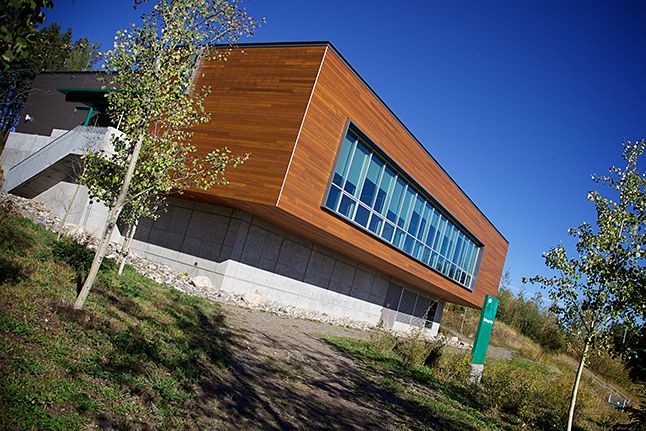
Following the success of the Pellet System, Phase 2 of the UNBC Energy Initiative saw the expansion of bioenergy at UNBC with start-up of the Bioenergy Plant on the Prince George campus in May 2011.
The Bioenergy Plant, the flagship component of the UNBC Energy Initiative, is a biomass gasification system designed by Vancouver-based Nexterra Systems Corp. The Bioenergy Plant uses gasification to convert sawmill residue into useable heat in the form of hot water. The hot water is distributed through our existing hot water district heating system and has offset roughly 85% of the fossil fuels previously used to heat the core campus buildings. This reduction has helped UNBC work towards its energy policy goals of reducing the fossil fuel consumption for space heating of all UNBC campuses by 80% by 2015.
The Bioenergy Plant has won many awards since its inception. Most recently, in August 2013, the Bioenergy Plant became the first university building in BC and the first building in the North to achieve LEED Platinum certification. Likewise, in June 2014, the Bioenergy Plant won the prestigious Canadian Green Building Award, presented by the Canadian Green Building Council.
System highlights
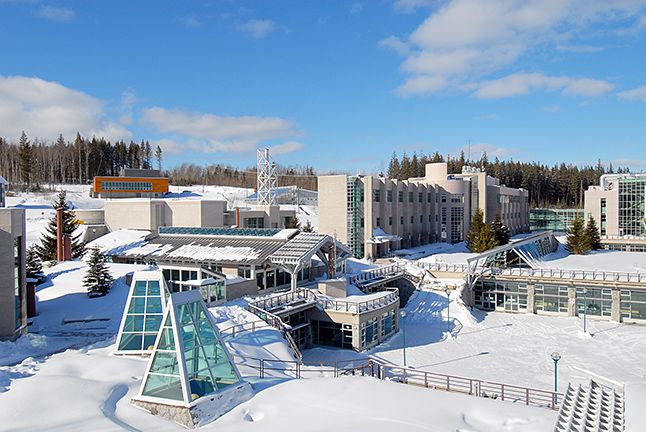
- Capital Cost: 15.7 Million
- Capacity: 4.4 MW (15 MMBtu/h)
- Buildings Heated: 10
- Fuel Input: 4,000 bdt/year hog fuel
- Heat Output: 60,000 GJ/year
- Emissions Reductions: 3,500 tonnes CO2e/year
Fuel
The fuel for the Bioenergy Plant is a sawmill residue from lumber production, called hog fuel, and consists of bark, shavings, chips and sawdust. Our hog fuel is supplied by Lakeland Mills in Prince George, and the trees are locally harvested within a 70km radius of Prince George. The Bioenergy Plant consumes roughly 6,000 green tonnes per year of hog fuel.
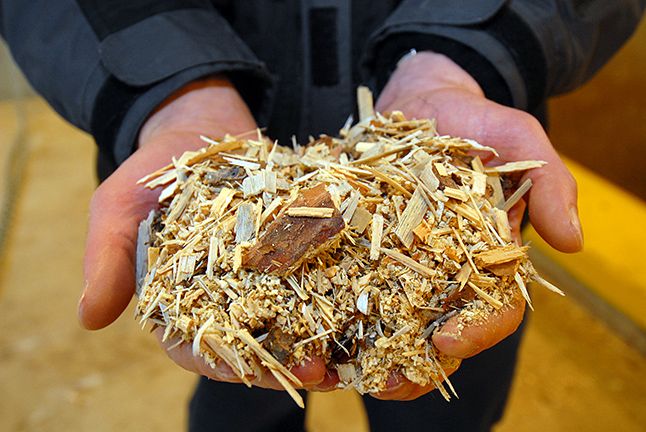
Sawmill residue from lumber production
The gasification process
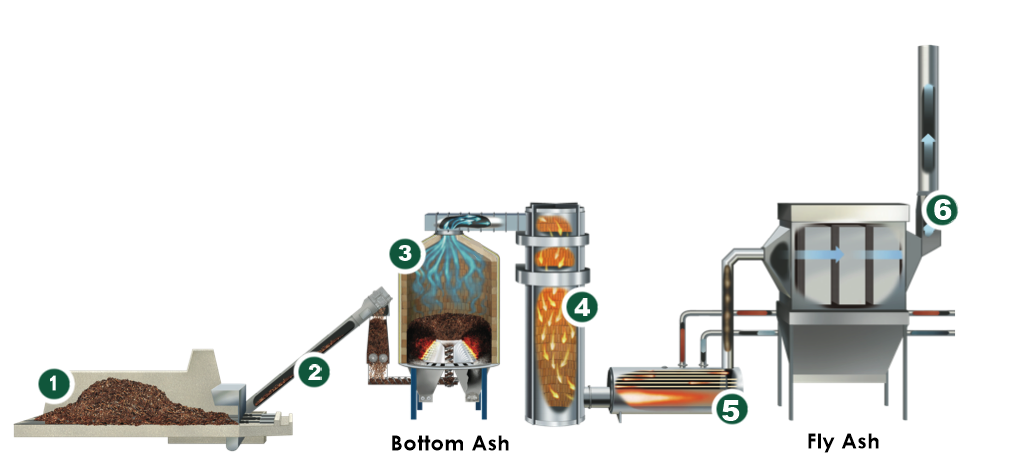
- Hog fuel from Lakeland Mills in Prince George is delivered to the fuel storage area. In a typical year, the UNBC Bioenergy Plant consumes over 4,000 bone dry tonnes of hog fuel.
- A conveyer moves the hog fuel to the base of the gasifier where it is fed into the Gasifier using a series of feed screws.
- Inside the Gasifier hot temperatures and restricted oxygen concentrations allow the hog fuel to undergo the gasification process where syngas is produced. The syngas exits through the top of the Gasifier and is drawn into the oxidizer. The ash remaining after the gasification process is continually emptied from the bottom of the Gasifier where it is conveyed and stored before being transported offsite.
- In the Oxidizer, Oxygen is added allowing for the syngas to combust. The temperature inside the oxidizer is roughly 1,200ᵒC.
- The hot gases from the oxidizer are drawn through the boiler where the heat is transferred to produce hot water. The hot water is pumped to the Prince George campus where the heat is transferred to the campus and then returned to the Bioenergy Plant to pick up more heat.
- After transferring most of its heat to water, the cooler gas passes through the electrostatic precipitator where any particulates are removed from the exhaust before being vented to the outdoors. Remarkably, the particulate emissions from the UNBC Bioenergy Plant are equivalent to heating systems that burn natural gas.
Emissions
The Bioenergy Plant was designed to produce emissions on par with heating systems that use natural gas. The Electrostatic Precipitator (ESP) removes particulate matter from the exhaust gas, enabling the Bioenergy Plant to operate with lower particulate emissions than the natural gas boilers it replaces.
Third-party testing of the Bioenergy Plant has demonstrated that the facility has among the lowest emissions of any bioenergy plant in North America, producing particulate emissions 18 times lower than typical bioenergy systems, and half as much as natural gas systems.

Interior of the Bioenergy Plant
Integrated Research Laboratory
UNBC’s bioenergy projects are also creating an array of educational and interdisciplinary research opportunities that are of great value to forest-based communities across Canada. UNBC's ability to integrate our teaching, research, and operational activities in the use of bioenergy recently resulted in being honoured with the top campus sustainability award in North America.
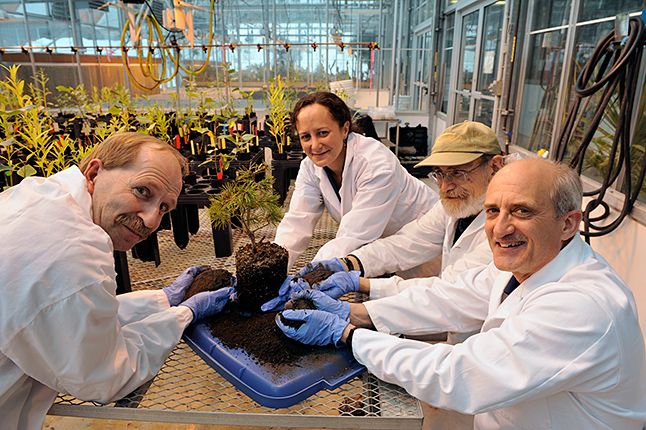
Recent research from the University of Northern British Columbia suggests that waste from municipalities and bioenergy plants can be combined to make an ideal fertilizer and help reduce the amount of material added to landfills. The study provides the first insights into the use of wood ash and biosolids as soil amendments for nurseries, forests, and mines in a northern boreal climate.
Funding partners
The Bioenergy Plant was funded by the following partners:
- Knowledge Infrastructure Program
- Public Sector Energy Conservation Agreement
- Innovative Clean Energy Fund
The building was designed with sustainability in mind
Beyond the benefits of renewable energy production, the Bioenergy Plant itself was designed and constructed with sustainability in mind. In August 2013, the Bioenergy Plant was certified LEED Platinum, the highest level of LEED certification. Following that, in 2014 the Bioenergy Plant won the prestigious Canadian Green Building Award in 2014, a first in Northern BC. Only 50 buildings nationwide have been awarded the Canadian Green Building Award. The Bioenergy Plant facility was designed by Hughes Condon Marler Architects and built by IDL Projects Inc. of Prince George.
LEED certification covers a wide range of environmental, economic and social attributes, including sustainable site design, water and energy conservation, materials recycling, indoor air quality, and innovative design.
Awards
The Bioenergy Plant has won numerous awards over its construction and three years of operations, including:
- Newsmaker of the Year 2011 - Northern BC Technology and Innovation Awards
- Excellence in Architectural Design – City of Prince George
- LEED Platinum
- Canada Green Building award
- Top North American campus sustainability project (tied with Harvard University) - Association for the Advancement of Sustainability in Higher Education (AASHE)
- Northern BC Business and Technology Innovator of the Year
- City of Prince George architectural design award